January 10, 2014
Atop a Pillar of Fire, I Journey to Red Duna
I sit 113 meters above the launch pad atop the Kerbasus-Kermes III, 964 tons of metal, rocket fuel and fission reactors poised to carry me once more into the dark of space, this time to red Duna. As I sit here in my chair, the mighty rocket swaying gently, with the now familiar cacophony of creaks, bangs, whirrs and roars filling the capsule while the chatter of mission control fills my helmet, I feel calm.
The final boost is almost anti-climatic. The final stage of the Kerbasus carries me into orbit, and I've very nearly gotten it circular; apoapsis 102,000 meters; periapsis 96,000 meters. Planning has covered this possibility, with a perfectly circular orbit so close, it's worth burning some fuel from the transfer stage to get it. I disable the safety interlocks, and release the nuclear genie from it's bottle. For 12 seconds, fast neutrons add their magic to the combustion chambers behind me, and four white tongues of plasma stretch out behind me. The sound of these engines is different, there is a rushing overtone to the roar, and the rocket gently slides into parking orbit above Kerbin.
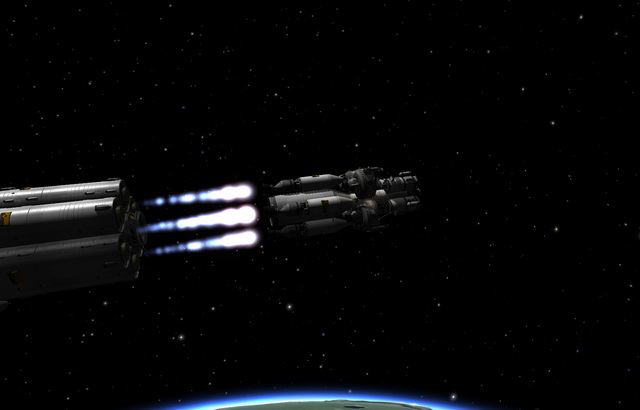
With the rocket in orbit, the engines silent, and the nuclear genie safely back into it's bottle for a time, I venture outside for a visual inspection of my craft. If anything has gone wrong, this will be my last chance to abort. The solar panels have deployed, and the readings confirm that the batteries are charging. The suit radiation sensors report that the nozzles are hot, but not yet dangerously so. The transfer stage, lander, and return craft all look good, and the instruments all agree. All checks are green, and I'm going to Duna. I spend a last few minutes to look at the blue Jewel of Kerbin below me, and then it's back inside to prepare for the transfer burn.
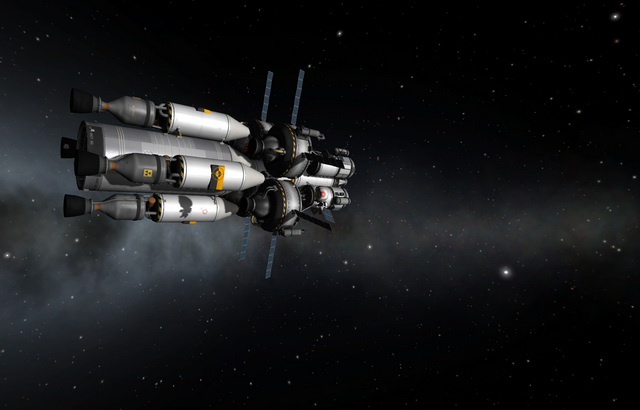
Duna is 45 degrees ahead of Kerbin, but Kerbin, and of course my rocket and I, are orbiting Kerbol at a much higher speed. I will use a Hohmann transfer orbit, just like what I've done to get to the Mun and Minmus, putting myself on course for a wider, slower orbit, timed so that I'll reach apoapsis in Duna orbit just as Duna itslef arrives at that position. The burn takes over four minutes, longer than any single burn I've done so far, but there is still nearly half a tank of fuel available when it's over.
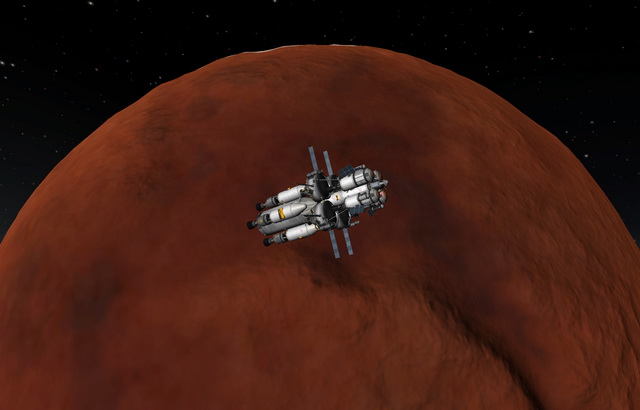
T+84 days, 1500 hours. I'm now in orbit above Duna. I've placed the rocket in a nearly circular orbit, with a 60 degree inclination that crosses the edge of the polar ice sheets. Time for a last EVA to shut down the running expirements and take some readings from here close to Duna.
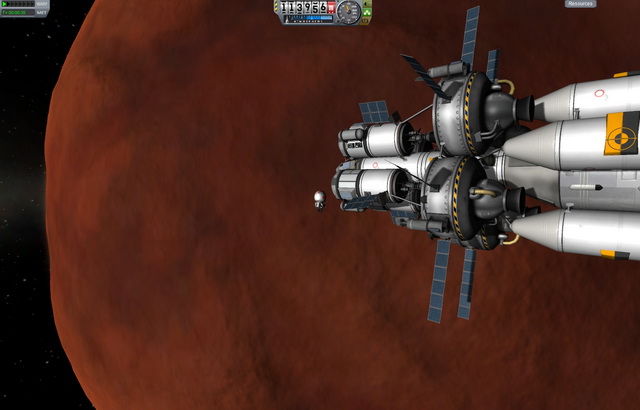
T+85 days, 0100 hours. I'm now descending toward the surface of Duna. From orbit, this looked like as flat a spot as I could find, but as I get closer, it's appearing pretty bumpy. I'd like to back off on my descent angle a bit and move on to another spot, but I really have no idea how the craft would handle that, or how much fuel I truly need, so I'm going to keep on profile and hope for the best.
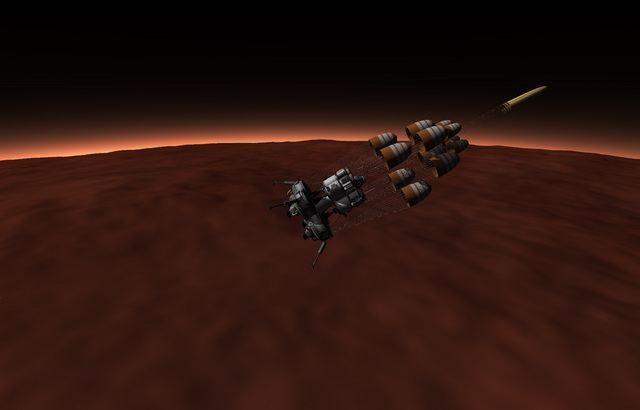
T+85 days, 0103 hours. As expected, even the huge number of chutes I deployed didn't slow me down very much, the air is very thin here. But they have gotten me down to a speed that the rockets can handle easily. It's looking like the ground is flat enough for a good landing, I'll find out soon.
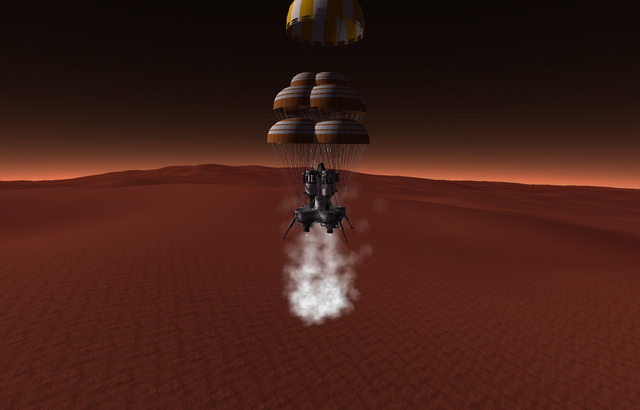
T+85 days, 0106 hours. I snuck a small bottle of fine aged brandy into the capsule, and let me tell you, it's been hard to keep it untouched this long. But after that landing, I needed it. I really thought the lander was going to roll over on me.
Comments are disabled.
Post is locked.
My thoughts go back to an interview I gave a few weeks ago during the parliamentar investigations into the Kerbasus I failure. Kalther Kerman asked me how it was that I could watch rockets fail on test, explain rationally to parliament the myriad dangers innate to the exploration of space, and yet climb into the capsule time and time again, to go out into space, perhaps to die. I find that the answer I so glibly gave then still holds:
"Because if I don't, who will? And if nobody does, if no Kerbal ventures out to explore the universe, to go to the farthest corners of creation, place their footprint into the virgin dust of new and remote places, the universe will be a much poorer place for it."
I am Jebediah Kerman, and in a few minutes I will blaze a trail of fire and smoke into the heavens. Perhaps I will go to Duna. Perhaps I will come back. Whether I succeed, or whether I fail, I can't imagine being anywhere but here, doing anything but this.
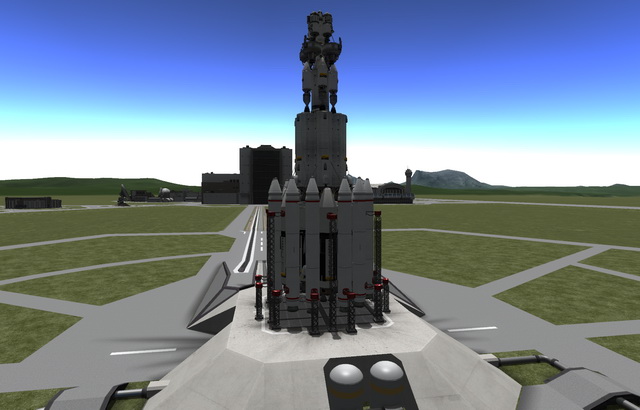
The chatter from mission control intensifies, until I hear Kene Kerman call the final status check. All is green, and we are go for launch.

T minus one minute.
I check my position in the seat one last time, making sure that during my hours here in the capsule I haven't dislodged anything.
T minus 15 seconds.
My eyes pass over the controls, as my hands and fingers probe around me, making sure that everything remains in perfect readiness.
T minus 5 seconds, and the slow hiss of the fuels pumps maintaining pressure beneath me rumbles louder and louder. I can no longer hear the count in my headphones, but I don't need it, I can feel it through the vibrations of the rocket, hear it in the roar around me. Still, even knowing it was coming, having done this a dozen times, the thundering boom, ripping the very air out of my lungs as I'm smashed down into the seat, is a surprise as always.
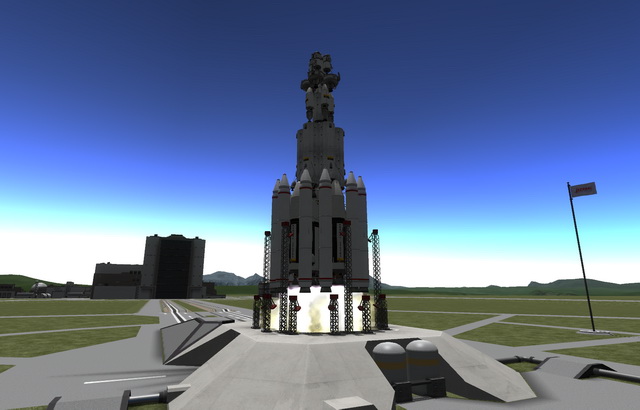
The Kerbasus is alive underneath me, and we move into the sky. The sensation is familiar, and yet at the same time completely unlike anything else I've ever experienced. The huge beast beneath me moves ponderously, nearly 1000 tons doesn't move quickly no matter how hard we thrust, but the intent in the movement is palpable. There is no wasted trembling, no sway, we're going straight up and nothing will stop us.
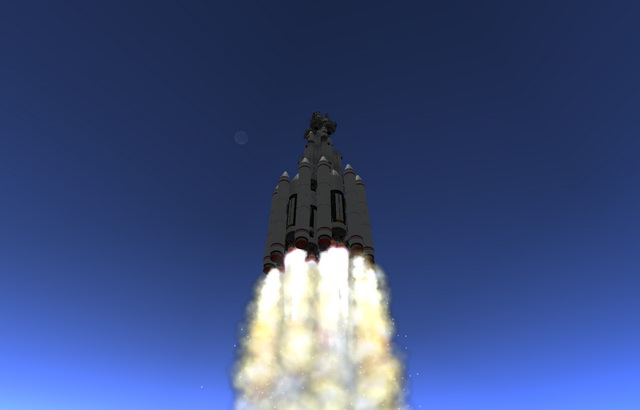
T+55 seconds, and the solid's are exhausted. Even over the roar of 26 rockets, I hear the bang as one of the boosters rolls into the exhaust and is disentegrated in a blink. But we remain steady, all lights read green, and control confirms that we've taken no damage.
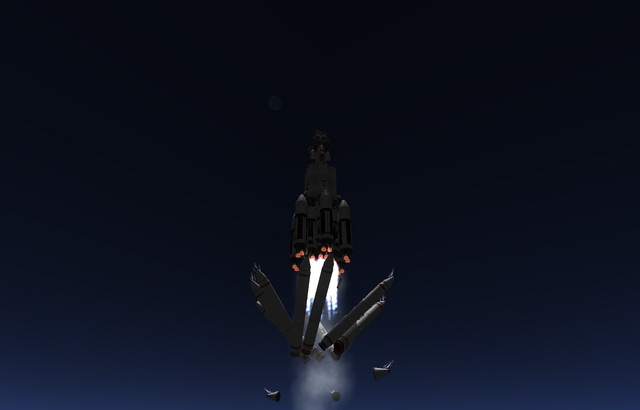
T+60 seconds, and the next set of boosters go silent. The rocket jolts as we lose all that thrust, then jolts again as the radials ignite. These boosters fall straight off without incident, and the sky is turning dark around me.
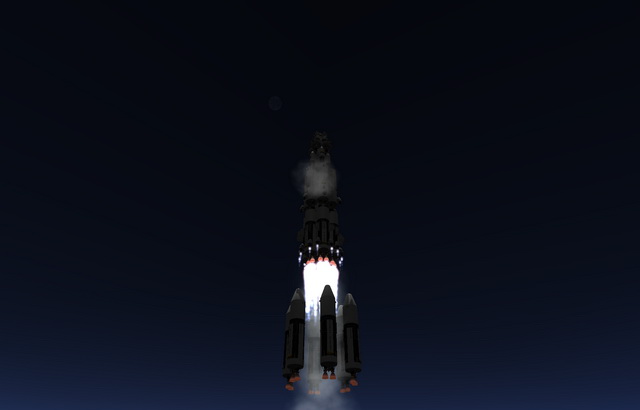
T+80 seconds, and I begin the gravity turn at 15,000 meters. For the first time, I feel the monster tremble. There is some obvious flex, perhaps where the transfer stage meets the lander, but it's not bad, and damps out nicely. I'm just nosing through 30 degrees when the launch core finally goes quiet.
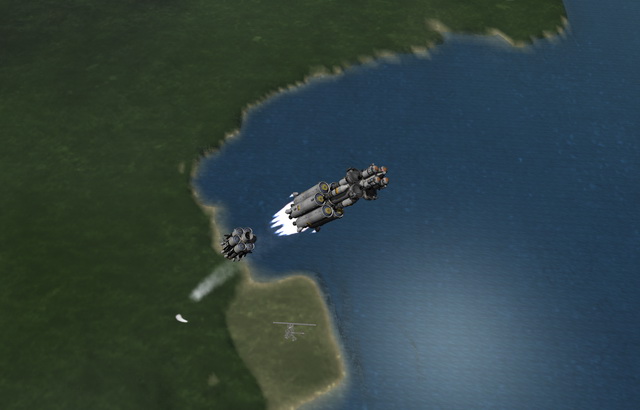
The jolt this time is more dramatic. 20 engines shut down, a massive chunk of metal falls off the back of the rocket, and then another 20 engines roar into life. I feel much like the time I was kicked by a bull in Kermplona. My ears ring, and my vision is a tunnel ringed with specks of light. But I regain function quickly, and my hands have remained steady on the controls. Only a few more seconds until we can shut down and coast out of the atmosphere.
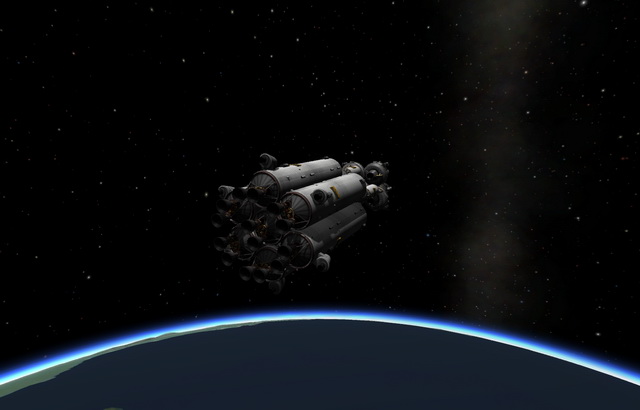
Coasting upwards to apoapsis, the craft now silent around me, and with more than half our mass gone, it becomes much easier to bring the nose down onto course. The initial stages have carried me above 45,000 meters, and apoapsis is above 90,000, over two minutes from now.






I welcome the chance to stretch my arms, shake out my fingers off the controls, and shake off the last remnants of tunnel vision. All too soon those mighty engines will fire again, this time with no air resistance to impede our progress.


T+25 days. This time alone has been surprisngly therapuetic. The big brains suggested I should take up a hobby to keep myslef occupied, and I wanted to try scrimshaw, but the engineers couldn't come up with a way to collect the shavings. Instead, I've been teaching myself to play saxophone. It should prove handy when we move to multi-kerbal missions soon.
T+34 days. Time for a mid-course correction. The initial burn put me on a course that would bring me within a million kilometers of Duna, but we want to do better than that, and here at the ascending node is the most efficient place to burn. My current trajectory has me on course to pass Duna below and from the outside, with Duna passing from behind. I need to accelerate a little, and bend my course inwards and up. From this position, only a few seconds of thrust is sufficient to bring my projected closest approach within 200,000 meters of Duna.
T+40 days. The scientists want me to begin running some expirements out here in deep space. I spend nearly three hours EVA. I can just barely tell which dots in the sky are Kerbin and Duna. The sensation of isolation from the EVA makes getting back into the tiny capsule a relief.
T+72 days. Duna and it's moon Ike are now clearly visible to the naked eye. I go outside every few days to monitor the expirements and get out of the capsule, and each time Duna is a little bigger, a little brighter, a little more red.
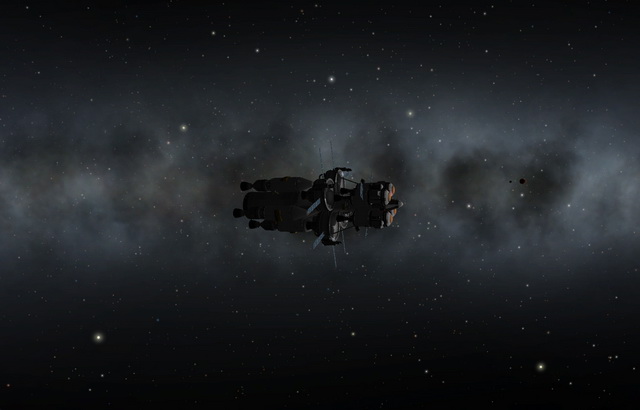

T+84 days 0800 hours. Duna now fills the sky as we pass inside Ike's orbit and make our closest approach. I'm on course to approach to 124,000 meters, then continue past into a Kerbol orbit. The mission planners and I have considered many options for this next burn. Some of the planners wanted to put me in an ecentric orbit that would let me do a close flyby of Ike before landing on Duna, but I had to agree with bypassing that option. I really want to get my feet down on the solid ground of Duna. Perhaps next time.




Oh, musn't forget: "I stand here to represent the aspirations of all Kerbal kind. I come in peace as a visitor to this world, and stake no claims other than the very spot of this flag. Jeb was here."
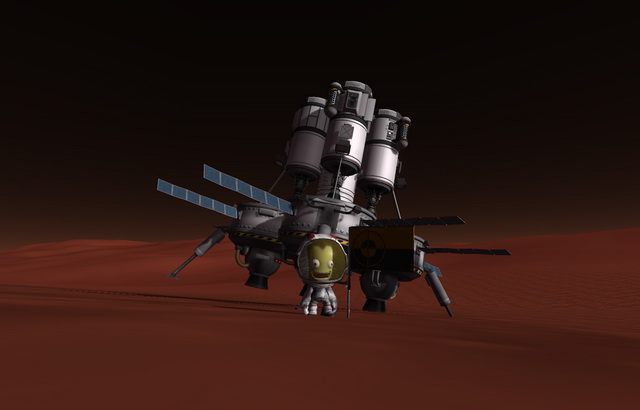
T+217 days. I'll save the rest of the log for my book. It's been a long stay here on Duna, but I'm sure the scientists will benefit greatly from the data I bring back. But now, finally, the launch window is open and it's time to head home. I've still got almost half a tank of fuel in the lander stage, so I'm going to use that for launch. I plan to essentially reverse my course, heading east on launch for a circular orbit at 45,000 meters.
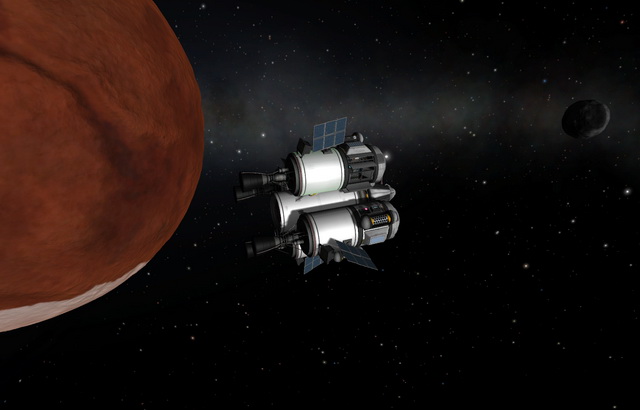
T+218 days. Headed home at last. Achieving orbit over Duna used up the last fuel of the lander, and the merest trickle from the return vehicle. I launched a bit early, and had to orbit Duna for five days before my transfer burn. Now I've got a trajectory for a straight Kerbin intercept, and a third of a tank of fuel to adjust. Have the champagne ready!
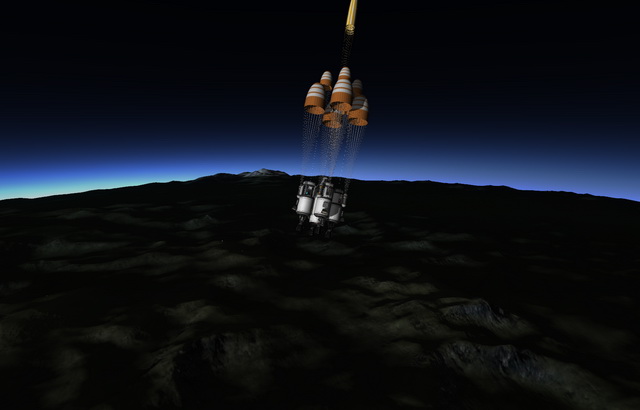
Not my finest landing, perhaps I should have put myself into a Kerbin parking orbit and spent the time to choose a good landing spot, instead of these mountains. But as they say "any landing you can walk away from is a good landing." I think I can see the beach from here, the recovery convoy can come find me there.
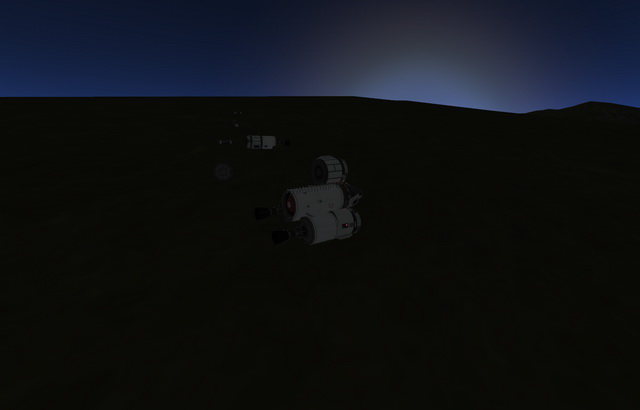




Posted by: TheSquirrelPatrol at
04:24 AM
| Comments (2)
| Add Comment
Post contains 2017 words, total size 15 kb.
1
KSP rocketship design seems to involve a lot of "if more is good, a LOT more is better," doesn't it?
Great travelogue!
Great travelogue!
Posted by: GreyDuck at January 13, 2014 07:42 PM (3m7pZ)
2
Indeed, more is good, a lot more is better, ludicrously more is best.
The lander for this mission was pretty heavy, and the transfer stage was a bit over-sized even so. With that much mass at the top, the launch stage had to get pretty big. It actually took me several iterations of "surely THIS will be way more than I need..." before I could get it into orbit without using the transfer stage for half or more of the circularizing burn.
The lander for this mission was pretty heavy, and the transfer stage was a bit over-sized even so. With that much mass at the top, the launch stage had to get pretty big. It actually took me several iterations of "surely THIS will be way more than I need..." before I could get it into orbit without using the transfer stage for half or more of the circularizing burn.
Posted by: David at January 16, 2014 06:24 AM (da+4f)
23kb generated in CPU 0.0281, elapsed 0.1156 seconds.
36 queries taking 0.0959 seconds, 57 records returned.
Powered by Minx 1.1.6c-pink.
36 queries taking 0.0959 seconds, 57 records returned.
Powered by Minx 1.1.6c-pink.









